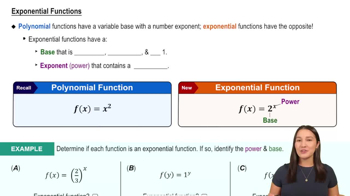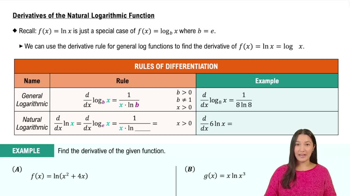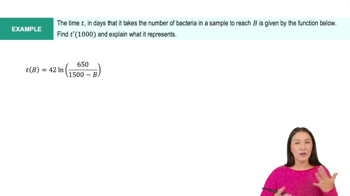Table of contents
- 0. Functions7h 52m
- Introduction to Functions16m
- Piecewise Functions10m
- Properties of Functions9m
- Common Functions1h 8m
- Transformations5m
- Combining Functions27m
- Exponent rules32m
- Exponential Functions28m
- Logarithmic Functions24m
- Properties of Logarithms34m
- Exponential & Logarithmic Equations35m
- Introduction to Trigonometric Functions38m
- Graphs of Trigonometric Functions44m
- Trigonometric Identities47m
- Inverse Trigonometric Functions48m
- 1. Limits and Continuity2h 2m
- 2. Intro to Derivatives1h 33m
- 3. Techniques of Differentiation3h 18m
- 4. Applications of Derivatives2h 38m
- 5. Graphical Applications of Derivatives6h 2m
- 6. Derivatives of Inverse, Exponential, & Logarithmic Functions2h 37m
- 7. Antiderivatives & Indefinite Integrals1h 26m
- 8. Definite Integrals4h 44m
- 9. Graphical Applications of Integrals2h 27m
- 10. Physics Applications of Integrals 2h 22m
6. Derivatives of Inverse, Exponential, & Logarithmic Functions
Derivatives of Exponential & Logarithmic Functions
Problem 56a
Textbook Question
The energy (in joules) released by an earthquake of magnitude M is given by the equation E = 25,000 ⋅ 101.5M. (This equation can be solved for M to define the magnitude of a given earthquake; it is a refinement of the original Richter scale created by Charles Richter in 1935.)
Compute the energy released by earthquakes of magnitude 1, 2, 3, 4, and 5. Plot the points on a graph and join them with a smooth curve.
 Verified step by step guidance
Verified step by step guidance1
Understand the given formula for energy released by an earthquake: E = 25,000 ⋅ 10^(1.5M). This formula relates the magnitude M of an earthquake to the energy E it releases.
To compute the energy for each magnitude, substitute the values of M (1, 2, 3, 4, and 5) into the formula one by one. For example, for M = 1, calculate E = 25,000 ⋅ 10^(1.5 * 1).
Repeat the substitution for each magnitude: M = 2, M = 3, M = 4, and M = 5, calculating the corresponding energy E for each case using the formula E = 25,000 ⋅ 10^(1.5M).
Once you have calculated the energy values for each magnitude, plot these points on a graph with the magnitude M on the x-axis and the energy E on the y-axis.
After plotting the points, draw a smooth curve through them to visualize how the energy released by an earthquake increases with its magnitude. This curve will help illustrate the exponential relationship between magnitude and energy.
 Verified video answer for a similar problem:
Verified video answer for a similar problem:This video solution was recommended by our tutors as helpful for the problem above
Video duration:
6mPlay a video:
Was this helpful?
Key Concepts
Here are the essential concepts you must grasp in order to answer the question correctly.
Exponential Functions
The equation E = 25,000 ⋅ 10^(1.5M) is an example of an exponential function, where the variable M (magnitude) affects the energy E exponentially. In exponential functions, a constant base is raised to a variable exponent, leading to rapid growth or decay. Understanding how to manipulate and evaluate exponential functions is crucial for calculating energy values for different magnitudes.
Recommended video:

Exponential Functions
Magnitude Scale
The magnitude of an earthquake, represented by M, is a logarithmic scale that quantifies the size of seismic events. Each whole number increase on the Richter scale corresponds to a tenfold increase in measured amplitude and approximately 31.6 times more energy release. This concept is essential for interpreting the results of the energy calculations and understanding the relationship between magnitude and energy.
Recommended video:

Properties of Functions
Graphing Data
Graphing involves plotting calculated values on a coordinate system to visualize relationships between variables. In this case, the magnitudes (M) will be plotted on the x-axis and the corresponding energy values (E) on the y-axis. Understanding how to create and interpret graphs is vital for analyzing the results and observing trends, such as the smooth curve that represents the relationship between magnitude and energy.
Recommended video:

Graphing The Derivative

 4:50m
4:50mWatch next
Master Derivatives of General Exponential Functions with a bite sized video explanation from Callie
Start learningRelated Videos
Related Practice














